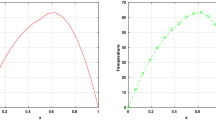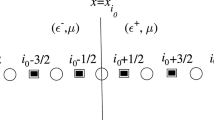Abstract
Galerkin finite element method is applied to dual-phase-lag bio heat model in heterogeneous medium. Well-posedness of the model interface problem and a priori estimates of its solutions are established. Optimal a priori error estimates for both semidiscrete and fully discrete schemes are proved in \(L^\infty (L^2)\) norm. The fully discrete space-time finite element discretizations is based on second order in time Newmark scheme. Finally, numerical results for two dimensional test problems are presented in support of our theoretical findings. Finite element algorithm presented here can contribute to a variety of engineering and medical applications.








Similar content being viewed by others
References
Adams, R.A., Fournier, J.J.F.: Sobolev Spaces, 2nd edn. Academic Press, Amsterdam (2003)
Ammari, H., Chen, D., Zou, J.: Well-posedness of an electric interface model and its finite element approximation. Math. Models Meth. Appl. Sci. 26, 601–625 (2016)
Antonietti, P., Mazzieri, I., Muhr, M., Nikolić, V., Wohlmuth, B.: A high-order discontinuous Galerkin method for nonlinear sound waves, arXiv:1912.02281 (2019)
Baker, G.A.: Error estimates for finite element methods for second order hyperbolic equations. SIAM J. Numer. Anal. 13, 564–576 (1976)
Basson, M., Stapelberg, B., Van Rensburg, N.F.J.: Error estimates for semi-discrete and fully discrete galerkin finite element approximations of the general linear second-order hyperbolic equation. Numer. Funct. Anal. Optim. 38, 466–485 (2017)
Chen, Z., Zou, J.: Finite element methods and their convergence for elliptic and parabolic interface problems. Numer. Math. 79, 175–202 (1998)
Dai, W., Wang, H., Jordan, P.M., Mickens, R.E., Bejan, A.: A mathematical model for skin burn injury induced by radiation heating. Int. Jour. Heat Mass Transf. 51, 5497–5510 (2008)
Deka, B., Ahmed, T.: Convergence of finite element method for linear second order wave equations with discontinuous coefficients. Numer. Methods Partial Differ. Equ. 29, 1522–1542 (2013)
Deka, B., Dutta, J.: \(L^{\infty }(L^2)\) and \(L^{\infty }(H^1)\) norms error estimates in finite element methods for electric interface model, accepted in Applicable Analysis, https://doi.org/10.1080/00036811.2019.1643010
Joseph, D.D., Preziosi, L.: Heat Waves. Rev. Mod. Phys. 61, 41–73 (1989)
Joshi, A.A., Majumdar, A.: Transient ballistic and diffusive phonon heat transport in thin films. J. Appl. Phys. 74, 31–39 (1993)
Kaltenbacher, B., Lasiecka, I.: Global existence and exponential decay rates for the Westervelt equation. Discrete Contin. Dyn. Syst.-S 2, 503–523 (2009)
Karaa, S.: Error estimates for finite element approximations of a viscous wave equation. Numer. Funct. Anal. Optim. 32, 750–767 (2011)
Kumar, P., Kumar, D., Rai, K.N.: A numerical study on dual-phase-lag model of bio-heat transfer during hyperthermia treatment. J. Thermal Biol. 49, 98–105 (2015)
Lagnese, J.E., Leugering, G., Schmidt, E.J.P.G.: Modeling Analysis and Control of Dynamic Elastic Multi-link Structures. Birkhäuser, Boston (1994)
Larsson, S., Thomée, V., Wahlbin, L.B.: Finite element methods for a strongly damped wave equation. IMA J. Numer. Anal. 11, 115–142 (1991)
Li, J.Z., Melenk, J.M., Wohlmuth, B., Zou, J.: Optimal a priori estimates for higher order finite elements for elliptic interface problems. Appl. Numer. Math. 60, 19–37 (2010)
Lim, H., Kim, S., Douglas, J.: Numerical methods for viscous and nonviscous wave equations. Appl. Numer. Math. 57, 194–212 (2007)
Lions, J.L., Magenes, E.: Non-Homogeneous Boundary Value Problems and Application, vol. II. Springer-Verlag, New York (1972)
Liu, K.-C., Chen, H.-T.: Investigation for the dual phase lag behavior of bio-heat transfer. Int. J. Thermal Sci. 49, 1138–1146 (2010)
Luikov, A.: Application of irreversible thermodynamics methods to investigation of heat and mass transfer. Int. J. Heat Mass Transf. 9, 139–152 (1966)
Mitra, K., Kumar, S., Vedavarz, A., Moallemi, M.K.: Experimental evidence of hyperbolic heat conduction in processed meat. J. Heat Transf. 117, 568–573 (1995)
Narasimhan, A., Sadasivam, S.: Non-Fourier bio heat transfer modelling of thermal damage during retinal laser irradiation. Int. J. Heat Mass Transf. 60, 591–597 (2013)
Nikolić, V., Kaltenbacher, B.: On higher regularity for the Westervelt equation with strong nonlinear damping. Appl. Anal. 95, 2824–2840 (2016)
Nikolić, V., Wohlmuth, B.: A priori error estimates for the finite element approximation of Westervelt’s quasi-linear acoustic wave equation. SIAM J. Numer. Anal. 57, 1897–1918 (2019)
Pani, A.K., Yuan, J.Y.: Mixed finite element method for a strongly damped wave equation. Numer. Methods Partial Differ. Equ. 17, 105–119 (2001)
Pennes, H.H.: Analysis of tissue and arterial temperature in the resting human forearm. J. Appl. Physiol. 1, 93–122 (1948)
Qiu, T.Q., Tien, C.L.: Short-pulse laser heating on metals. Int. J. Heat Mass Transf. 35, 719–726 (1992)
Ren, X., Wei, J.: On a two-dimensional elliptic problem with large exponent in nonlinearity. Trans. Am. Math. Soc. 343, 749–763 (1994)
Robinson, J.C.: Infinite-Dimensional Dynamical System: An Introduction to Dissipative Parabolic PDEs and the Theory of Global Attractors, Cambridge Texts in Applied Mathematics (2001)
Showalter, R.E.: Hilbert Space Methods for Partial Differential Equations. Pitman, London (1977)
Tzou, D.Y.: A unified field approach for heat conduction from macro- to micro-scales. Trans. ASME 117, 8–16 (1995)
Tzou, D.Y.: Macro- to Microscale Heat Transfer: The Lagging Behavior. Taylor & Francis, Washington, DC (1996)
Tzou, D.Y., Chiu, K.S.: Temperature-dependent thermal lagging in ultrafast laser heating. Int. J. Heat Mass Transf. 44, 1725–1734 (2001)
van Rensburg, N.F.J., van der Merwe, A.J.: Analysis of the solvability of linear vibration models. Appl. Anal. 81, 1143–1159 (2002)
van Rensburg, N.F.J., Stapelberg, B.: Existence and uniqueness of solutions of a general linear second-order hyperbolic problem. IMA J. Appl. Math. 84, 1–22 (2019)
Vedavarz, A., Kumar, S., Moallemi, M.K.: Significance of non-fourier heat waves in conduction. J. Heat Transf. 116, 221–226 (1994)
Xu, F., Lu, T.J., Seffen, K.A., Ng, E.Y.K.: Mathematical modeling of skin bioheat transfer. Appl. Mech. Rev. 62, 1–35 (2009)
Xu, F., Lu, T.J., Seffen, K.A.: Non-Fourier analysis of skin biothermomechanics. Int. Jour. Heat Mass Transf. 51, 2237–2259 (2008)
Acknowledgements
The authors are grateful to the anonymous referee for valuable comments and suggestions which greatly improved the presentation of this paper.
Author information
Authors and Affiliations
Corresponding author
Additional information
Publisher's Note
Springer Nature remains neutral with regard to jurisdictional claims in published maps and institutional affiliations.
Appendix
Appendix
Proof of Lemma 4.1:
Taking \( t\rightarrow 0^+ \) in (4.1) and then using definition of \(\mathcal{Q}_h\) operator, we obtain
Here, we have used the fact that \(u_h\in C^2(J; V_h)\). For the third term and fourth term in (7.3), we use Green’s formula and boundary condition to derive
Hence, (7.3) yields
In the previous estimate, we have used the fact that
In fact, for any Banach space \( \mathcal{B} \), we know that (cf. [30], Proposition 7.1)
Also, from the definition of \( \mathcal{Q}_h \) operator, we can easily derive
For \(i=3\), taking \( t\rightarrow 0^+ \) in (2.3) and using (7.3), we have
In the last inequality, we have used Lemmas 3.2 and 3.4, and the fact that \(u\in C^2(J; W)\). Then use definition of \(L^2\) projection and (7.7) to obtain
which imply
Estimate (7.9) together with inverse inequality and (3.19) yields
Next, for \(u_h\in C^3(J; V_h)\), we differentiate (4.1) with respect to t and then take \(t\rightarrow 0^+\) to have
Now, for \(u\in H^3(J; \mathcal{Y})\) or equivalently \(u\in C^2(J;\mathcal{Y})\), use the fact that
in the Eq. (7.11) to obtain
From (7.8) and Remark 3.1, we have
In the last inequality, we have used the fact that \(\Vert u_0\Vert _K\le Ch\Vert u_0\Vert _{2, K}\) for all \(K\in \mathcal{T}_h.\) Using (7.12) in (7.11), we obtain
The case \(i=4\) can be done in a similar way and hence details are omitted. This completes the rest of the proof. \(\square \)
Rights and permissions
About this article
Cite this article
Dutta, J., Deka, B. Optimal A Priori Error Estimates for the Finite Element Approximation of Dual-Phase-Lag Bio Heat Model in Heterogeneous Medium. J Sci Comput 87, 58 (2021). https://doi.org/10.1007/s10915-021-01460-9
Received:
Revised:
Accepted:
Published:
DOI: https://doi.org/10.1007/s10915-021-01460-9
Keywords
- General hyperbolic equation
- Heterogeneous medium
- Finite element method
- A priori analysis
- Optimal error estimates




